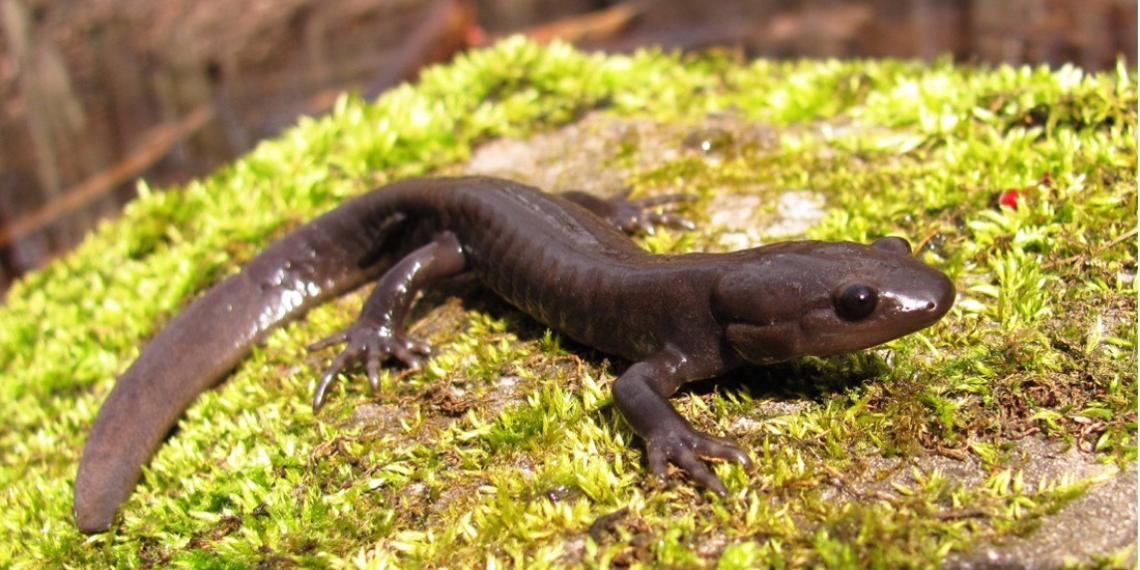Saving Salamanders: Scientists ‘map’ a path to protect an endangered species

Ontario’s Greenbelt is home to over 9 million people – including many of us here at the University of Guelph. But did you know that we also share the Greenbelt with a plethora of at-risk and endangered species such as the Jefferson salamander?
The Jefferson salamander is an endangered amphibian whose northern range extends into Ontario. It lives in isolated populations primarily within the Niagara Escarpment region, a highly urbanized and densely populated area.
Urbanization may provide many benefits to humans, but species such as the Jefferson salamander are having trouble keeping up. For instance, roads can block the salamanders’ movement, and cause death when salamanders are struck by vehicles.
To reduce the impacts of urbanization on endangered species, an understanding of where these species live is a critical first step. However, the location of the Jefferson salamander and their spring breeding ponds within southern Ontario is largely unknown.
Luckily, researchers in Dr. Ryan Norris’ lab in the Department of Integrative Biology were determined to help locate these breeding ponds and ultimately the Jefferson salamander, knowing that this information could help guide conservation strategies to protect these elusive animals.
“There are many breeding ponds that have been built over, and many of them are in people’s property,” says Andie Siemens, undergraduate researcher and lead author of the study. “If you don’t know which ponds are critical habitat, you cannot protect them from development.”
To try and locate this critical habitat, Siemens and Norris created a statistical model to map areas that are suitable – or not suitable – for the salamander’s survival. They then used the model to predict habitats with a high likelihood of containing their essential spring breeding ponds. To do this, Siemens incorporated known distribution information on the Jefferson salamander with environmental data such as temperature, soil type, and land type.
Results from the model showed that suitable Jefferson Salamander habitat in Ontario covers approximately 29,000 km2, spanning from the southern tip of Ontario to Georgian Bay.
As expected, areas within the Niagara Escarpment showed very high habitat suitability. Other areas of high habitat suitability were located primarily within conservation areas and along the north shore of Lake Ontario.
While highly urban areas tended to show low habitat suitability, a few places in lakeshore cities, including Toronto, Mississauga, Oakville, Burlington and Hamilton, actually showed moderate habitat suitability.
The model also predicted approximately 2,300 km2 of possible breeding pond habitat within southern Ontario. However, after refining the model to only include ponds surrounded by highly suitable habitat, this number dropped to only 305 km2. And while the model predicted a high likelihood of pond density within the Niagara Escarpment region, the rest of the province showed only a patchy distribution of ponds.
The results from this research will aid in decision making related to conservation boundaries and zoning. They will also help guide future field surveys on the Jefferson salamander within Southwestern Ontario.
Siemens and Norris’s study also highlights the crucial conservation value of the Greenbelt, primarily within the Niagara Escarpment region, to the Jefferson salamander. Unfortunately, this conservation value is being threatened by recent policies, which may allow further urbanization within the Greenbelt.
To help protect endangered species such as the Jefferson salamander within Ontario, both Siemens and Norris encourage the public to make use of their voting power.
“Protect the Greenbelt. Most of the predicted habitat was within the Greenbelt designation – if we protect that from development as much as we can, that is your biggest impact,” says Siemens. “If there are Jeffersons [salamanders] there, who knows what other species at risk are also in that habitat. If you protect one, you can help protect them all.”
Norris also encourages the use of citizen science tools such as iNaturalist, an online social network where the public can document species they observe in nature.
“Report salamanders when you see them,” he says. “Sometimes it’s hard for amateurs to identify them, but even just reporting what you see with programs like iNaturalist is helpful … after all, if we knew where they all were, we wouldn’t have to rely on models. It is a good way for people to get involved.”
Read the full study in the journal Endangered Species Research.
Read about other CBS Research Highlights.